Notes: The Hereford to Eardisley section of the Hereford, Hay & Brecon railway (HH&BR) was officially opened on 30 June 1863 with intermediate stations at Moorhampton, Westmoor (Private station) and Credenhill. On the opening day, a special train comprising nine carriages decorated with flowers and flags left Hereford station and made its first stop at Credenhill which was also decorated with flags for the occasion. The Hereford Journal recorded the occasion on 4 July 1863 stating: "There were no demonstrations of any kind either at Credenhill or Moorhampton." It is unclear if this means there were no spectators.
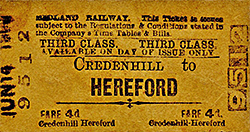 The station was located at the end of a short approach road on the east side of Station Road, one mile south west of Credenhill village. The station remained largely unaltered throughout its life and comprised a single platform on the north side of the line. The main station building was constructed of wood, probably supplied by the Gloucester Carriage and Wagon Works; it had a hipped slate roof. There was a separate gents' toilet at the west end of the building. At some time the building was extended at its east end. The station was located at the end of a short approach road on the east side of Station Road, one mile south west of Credenhill village. The station remained largely unaltered throughout its life and comprised a single platform on the north side of the line. The main station building was constructed of wood, probably supplied by the Gloucester Carriage and Wagon Works; it had a hipped slate roof. There was a separate gents' toilet at the west end of the building. At some time the building was extended at its east end.
The station was provided with a small goods yard with two sidings on the north side of the line. One siding ran behind the platform to a small 'L' shaped dock, the other ran diagonally across the yard serving the coal grounds. A weighbridge and office was provided alongside the approach road. There were no buildings in the yard but a grounded van at the end of the dock probably acted as a goods and parcels store. The yard only handled general goods and parcels and did not take livestock.
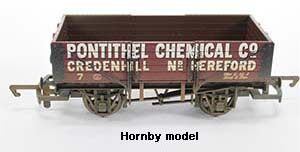 Half a mile north west of Credenhill a siding running parallel with the line on the south side was provided to serve the Pontithiel Chemical Company in 1873. It remained in use until the works closed in the 1920s. The Pontithiel Chemical Company used timber to produce charcoal, wood naphtha, wood tar and other products derived from wood. Half a mile north west of Credenhill a siding running parallel with the line on the south side was provided to serve the Pontithiel Chemical Company in 1873. It remained in use until the works closed in the 1920s. The Pontithiel Chemical Company used timber to produce charcoal, wood naphtha, wood tar and other products derived from wood.
Credenhill signal box was of typical Midland Railway design and probably constructed at the Midland Railway works at Derby. The wooden frame and panels were fabricated and then bolted together on site. The original box, built after 1873, was upgraded from time to time during its operational life. The box was sited to the east of the station on the south side; it was abolished by the LMS and subsequently removed in the late 1920s.
In 1917 an outpost of the Royal Ordnance Factory at Rotherwas was built to the east of the station on the north side and the substantial Credenhill railway sidings were opened to accommodate and serve it. ROF Rotherwas was a munitions filling factory located in Lower Bullingham, Herefordshire. The site was supplied with dichloroethyl sulphide by the National Smelting Company at Avonmouth Docks, and produced mustard gas shells. Rotherwas was the only ROF of 25 sites retained between the wars; it was put into care and maintenance from 1920. From 1926 onwards it resumed filling gas shells. The sidings were taken out of use in 1927 and the 1929 map, reproduced below, shows no evidence of the sidings or munitions factory - military sites were often omitted from OS maps. Aerial photos from 1946 clearly shows buildings were still standing.
In 1939, the Credenhill Railway Sidings was requisitioned and shortly after the outbreak of the Second World War preparations and construction of RAF Credenhill (also known as RAF Hereford) started with the non-flying station opening on 15 June 1940. This gave Credenhill station a new role dealing with the movement of RAF personnel and equipment. During the early war months the station became the headquarters of the Local Defence Volunteers (LDV), better known by its later name of the Home Guard.

There are many anecdotes surrounding the station, the people who worked there, and those who used it. One member of the LDV told of a surprise visit by the local commanding officer one evening when the squad were on duty at the station. It must be remembered that most of the men would have mustered after a full hard day's work, many would probably not have eaten and some would have come straight from shift work. Whatever the reason, one or two had grabbed the opportunity to get some much-needed sleep, others were playing darts and there was some horseplay. On seeing the chaotic scene that greeted his arrival, the visiting officer wanted to know who was the responsible NCO. Being informed that Sergeant Price was in charge, he enquired where Sgt. Price might be found. Quite unabashed one of the squad informed him that Sgt. Price had "popped off home to fetch a frying pan to cook the sausages".
The line and station were closed to all passenger traffic on 31 December 1962, but Credenhill, Eardisley and Moorhampton stations remained open for goods traffic until 28th September 1964.
The station site was sold in July 1970 as a result of a community led initiative for the construction of a social club and community centre by the Parish Council, with financial help from the RAF members stationed at Credenhill at that time. There was also an outdoor swimming pool with changing rooms. The new complex was opened on 18 August 1975. No part of the old station survives although it is said that a relic from the station is kept under the stage.
On 23 April 1994 RAF Credenhill closed. The site was obtained by the British Army to redevelop for the Special Air Service headquarters base, with the SAS subsequently moving from Hereford in 1999, and in 2000 the base was designated as Stirling Lines, the headquarters of the 22
Special Air Service Regiment.
BRIEF HISTORY OF THE HEREFORD HAY & BRECON RAILWAY
The first railway to Hay-on-Wye (then known as Hay) received its authorising Act of Parliament on 25 May 1811. A second Act of 20 May 1812 authorised a number of route changes. It was a plateway tramroad, to be worked by horses. Construction of the 24 mile tramway was completed from Brecon to Hay on 7 May 1816, and extended by stages to Eardisley by 1 December 1818.
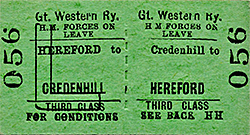 Despite the success of the tramroad, as railway technology developed it became apparent that towns served by a railway had an economic advantage over other places that were not so served. In August 1854 the Leominster, Hay and Brecon Railway was promoted, but it proved impossible to raise money for the scheme and it was dropped. The promoter, Captain Walter Devereux, was not deterred and at a public meeting in Hay on 12 November 1857 he launched the Hereford, Hay and Brecon Railway Company. Despite the success of the tramroad, as railway technology developed it became apparent that towns served by a railway had an economic advantage over other places that were not so served. In August 1854 the Leominster, Hay and Brecon Railway was promoted, but it proved impossible to raise money for the scheme and it was dropped. The promoter, Captain Walter Devereux, was not deterred and at a public meeting in Hay on 12 November 1857 he launched the Hereford, Hay and Brecon Railway Company.
Devereux was keen to build a low-cost railway, but at another meeting in Brecon on 21 July 1858, those present adopted a proposed line via Bronllys terminating on the hillside north of Brecon. Devereux believed that his idea had been abandoned and he withdrew from the project. The Hereford, Hay and Brecon Railway received its Act of Incorporation on 8 August 1859 to build 34 miles 15 chains of railway. Early in 1859 the HH&BR approached the Hay Railway, and agreement was reached on 6 November 1859, by which the Hay Railway would be purchased.
The first sod was turned by Lady Tredegar near Brecon on 10 April 1860. The HH&BR went south as far as Aberllynvy near Glasbury, and the junction station became known as Three Cocks Junction after an inn nearby. The powers to build from Aberllynvy to Talyllyn were transferred to the Mid-Wales Railway, and the powers from there to Brecon were transferred to the Brecon and Merthyr Railway.
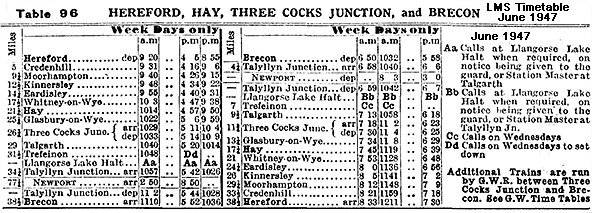
The authorising Act in 1859 set out an entry to Hereford at Barrs Court Junction, facing north. The junction was where the Newport, Abergavenny and Hereford Railway, running via Barton station, converged with the Shrewsbury and Hereford Railway, which ran from Barrs Court station, then a terminus, northwards. Barrs Court Junction would therefore have been a three-way convergence, and the junction was technically to be with the Shrewsbury and Hereford. Arriving HH&BR trains would reverse to either Barton or Barrs Court station, but there was to be a single-platform interchange station at the junction. This was obviously unsatisfactory and on 3 July 1860 the company was authorised by Parliament to abandon the S&HR connection, substituting a south-facing connection direct to Barton station of the NA&HR. The NA&HR, the Oxford, Worcester and Wolverhampton Railway and the Worcester and Hereford Railway amalgamated on 1 July 1860 to form the West Midland Railway. A new working arrangement was now made with the West Midland Railway: it would work the HH&BR line as soon as 20 miles of that line was completed and open.
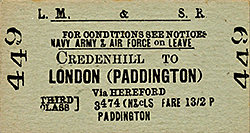 The first section to be opened was from Hereford to Moorhampton, opened for coal and lime traffic on 24 October 1862. An extension as far as Eardisley was opened on 30 June 1863, with a passenger service of four trains each way daily. The intention had been to use Barton as the Hereford terminus, and a connection into Barton had been used during the construction period by the contractor. However the Inspecting Officer of the Board of Trade declined to sanction the use of the contractor's connection for passengers, condemning it as "dangerous and almost impossible to work". The line was further extended to Hay on 11 July 1864. Finally from 19 September 1864 the entire line was open and a train service of six passenger and two freight trains each way on weekdays between Hereford and Brecon was introduced, using running powers over the newly-opened Mid-Wales Railway between Three Cocks and Talyllyn, and from there the trains ran over the Brecon and Merthyr Railway to Brecon. The first section to be opened was from Hereford to Moorhampton, opened for coal and lime traffic on 24 October 1862. An extension as far as Eardisley was opened on 30 June 1863, with a passenger service of four trains each way daily. The intention had been to use Barton as the Hereford terminus, and a connection into Barton had been used during the construction period by the contractor. However the Inspecting Officer of the Board of Trade declined to sanction the use of the contractor's connection for passengers, condemning it as "dangerous and almost impossible to work". The line was further extended to Hay on 11 July 1864. Finally from 19 September 1864 the entire line was open and a train service of six passenger and two freight trains each way on weekdays between Hereford and Brecon was introduced, using running powers over the newly-opened Mid-Wales Railway between Three Cocks and Talyllyn, and from there the trains ran over the Brecon and Merthyr Railway to Brecon.
At the time of the 1863 opening, it was clear that the West Midland Railway was going to amalgamate with the Great Western Railway. It did so by Act of 1 August 1863. The HH&BR had assumed that its partner companies at Hereford would have much to gain by using the HH&BR line for access to South Wales, but the considerable network of the GWR did not seem to offer that likelihood. A rapid cooling of relations followed immediately, with the issue of the junction at Barton unresolved.
In fact the GWR considered the HH&BR line worthy of developing as an ally, and their General Manager visited Hereford in November 1863 and agreed a compromise. A junction could be formed that did not directly cross the GWR (former NA&HR) line, but ran to the back (west side) of Barton station without making conflicting moves. An agreement was finalised on 24 August 1864, although many details were to be agreed later; the first HH&BR train ran into Barton station on 1 October 1864. The agreement stipulated that the facilities granted to the HH&BR might be transferred to the Brecon and Merthyr Railway if required. The HH&BR and the B&MR were discussing an amalgamation at the time.
In 1864 it was agreed that the LNWR and the GWR would construct a south curve, the Brecon Curve, near Barrs Court Junction, enabling through running from the Barton direction to Barrs Court without reversal. For its part the HH&BR would withdraw opposition to the Hereford Loop, and construct the Widemarsh Loop itself.

On 25 August 1865 the HH&BR amalgamated with the Brecon and Merthyr Railway, and this took effect from 25 August 1865. The combined company (also known as the Brecon and Merthyr Railway) was short of money. On 28 February 1867 the B&MR gave notice to the GWR that it would cease using the Barton station from 30 June 1867. This was a desperate attempt to save money, with B&MR trains now only running to Moorfields. The Widemarsh Loop was laid in but not connected at the north end, and the Brecon Curve was not started.
It emerged in 1867 that the amalgamation agreement had not been ratified by the Brecon and Merthyr preference shareholders, and in the Court of Chancery the amalgamation was declared void with the two companies separating but, due to the financial slump, the HH&BR resumed its independent existence in the hands of a receiver.
The Mid-Wales Railway arranged to run the now-independent HH&BR trains for twelve months from 1 October 1868, and the GWR allowed the Mid-Wales company to use Barton station.
The HH&BR emerged from receivership in 1869, but was still in a serious financial difficulty. A new act passed on 26 August 1869 authorised the Widemarsh Loop (again), and running powers to Brecon.
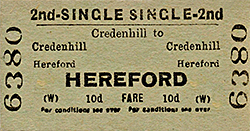 The Midland Railway wished to get access to South Wales by securing a base in the Swansea district, and the Midland opened negotiations with the HH&BR in July 1869. This quickly led to an agreement giving the Midland Railway "exclusive running powers" over the HH&BR system. The arrangement came into force on 1 October 1869. The GWR were dismayed at this turn of events, for they had been conducting negotiations with the HH&BR themselves. When the Midland Railway tried to run a train into Barton, the GWR station at Hereford, the GWR blocked the junction with an engine and wagons, refusing to allow the Midland to get access. The Midland Railway wished to get access to South Wales by securing a base in the Swansea district, and the Midland opened negotiations with the HH&BR in July 1869. This quickly led to an agreement giving the Midland Railway "exclusive running powers" over the HH&BR system. The arrangement came into force on 1 October 1869. The GWR were dismayed at this turn of events, for they had been conducting negotiations with the HH&BR themselves. When the Midland Railway tried to run a train into Barton, the GWR station at Hereford, the GWR blocked the junction with an engine and wagons, refusing to allow the Midland to get access.
The HH&BR sought a writ of mandamus in the High Court and succeeded in getting power to reinstate the junction at Barton, and to use Barton station as before. However these powers did not extend to the Midland Railway, and for the time being the GWR continued to block access to that company's trains. The GWR now demanded payment from the HH&BR for the earlier works that gave access to the HH&BR into Barton. The Midland continued to clash in court battles with the GWR over the claimed right to run their trains into Barton, and eventually they won. Nevertheless it was not until 1 April 1874 that Brecon trains resumed using Barton. They continued to use it until 1893, reversing their trains there and running a shuttle for through Worcester carriages to and from Barrs Court.
The Midland Railway took a full lease of the line by an Act of 30 July 1874 and finally absorbed the HH&BR in 1876. Midland trains started to work through to Swansea over the Neath and Brecon Railway and the Swansea Vale Railway on 2 July 1877. The use of Barton at Hereford was never entirely convenient, because Barrs Court was used by through trains and connections there were desirable. Antagonism between the respective companies (Midland, GWR and LNWR) resulted in any agreement being much delayed until 21 May 1891. The Midland Railway would now construct the Widemarsh Loop; the GWR would form the northern junction with it; the GWR and the LNWR would make and complete the Brecon curve; and the Midland would use Barrs Court station and vacate Barton.
The Brecon Curve was opened from 2 January 1893, and HH&BR (Midland) trains started to use Barrs Court. Midland Railway through coaches between Birmingham and Brecon, later Swansea, started running from 8 July 1873; they continued running until 31 December 1916.
Following the Railways Act 1921, the Midland Railway became a constituent of the new London, Midland and Scottish Railway; the Great Western Railway joined with certain other railways and continued under the same name. The LMS discontinued through passenger trains between Swansea and Hereford from 1 January 1931. The Midland Railway had never developed the line for through express passenger working; its purpose was simply the carriage of goods to and from Swansea, and local passenger traffic was run as an incidental activity.
Purely local passenger and goods business in a rural area was susceptible to road competition, and indeed income had always been weak. The line was closed to passengers on 30 December 1962, and to all traffic in 1964, from Talyllyn Junction to Eardisley on 4 May 1964, and throughout on 4 August 1964.
Route map drawn by Alan Young, Tickets from Michael Stewart
Sources:
- Wikipedia - History of the Hereford Hay & Brecon Railway. Text coped under creative commons licence.
- Wikipidea - ROF Rotherwas
- Credenhill Station - Guest essay Hereford Council web site
- Credenhilll Parish Council
- Credenhill Community Hall
|

old1.jpg)

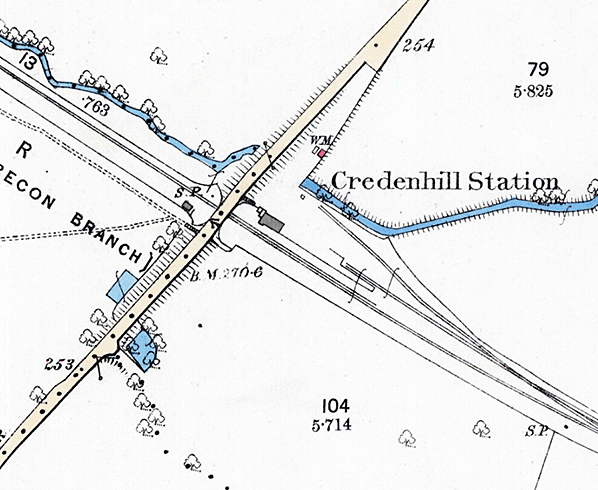
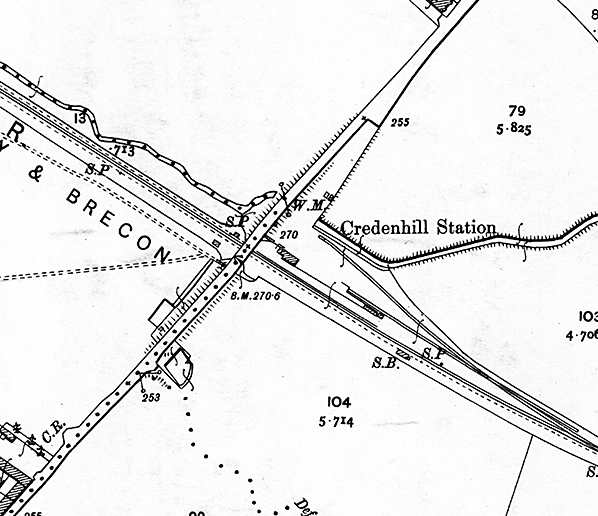
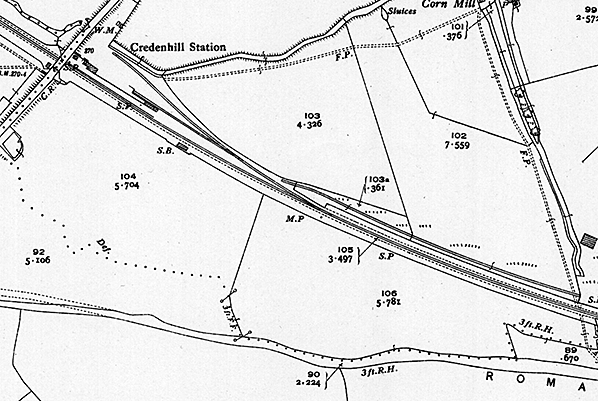
old2.jpg)
old6.jpg)
old7.jpg)
old8.jpg)
16.jpg) Credenhill station looking south-west along the platform on a bright winter day in the early 1960s.
Credenhill station looking south-west along the platform on a bright winter day in the early 1960s.
 The station was located at the end of a short approach road on the east side of Station Road, one mile south west of Credenhill village. The station remained largely unaltered throughout its life and comprised a single platform on the north side of the line. The main station building was constructed of wood, probably supplied by the Gloucester Carriage and Wagon Works; it had a hipped slate roof. There was a separate gents' toilet at the west end of the building. At some time the building was extended at its east end.
The station was located at the end of a short approach road on the east side of Station Road, one mile south west of Credenhill village. The station remained largely unaltered throughout its life and comprised a single platform on the north side of the line. The main station building was constructed of wood, probably supplied by the Gloucester Carriage and Wagon Works; it had a hipped slate roof. There was a separate gents' toilet at the west end of the building. At some time the building was extended at its east end. Half a mile north west of Credenhill a siding running parallel with the line on the south side was provided to serve the Pontithiel Chemical Company in 1873. It remained in use until the works closed in the 1920s. The Pontithiel Chemical Company used timber to produce charcoal, wood naphtha, wood tar and other products derived from wood.
Half a mile north west of Credenhill a siding running parallel with the line on the south side was provided to serve the Pontithiel Chemical Company in 1873. It remained in use until the works closed in the 1920s. The Pontithiel Chemical Company used timber to produce charcoal, wood naphtha, wood tar and other products derived from wood.
 Despite the success of the tramroad, as railway technology developed it became apparent that towns served by a railway had an economic advantage over other places that were not so served. In August 1854 the Leominster, Hay and Brecon Railway was promoted, but it proved impossible to raise money for the scheme and it was dropped. The promoter, Captain Walter Devereux, was not deterred and at a public meeting in Hay on 12 November 1857 he launched the Hereford, Hay and Brecon Railway Company.
Despite the success of the tramroad, as railway technology developed it became apparent that towns served by a railway had an economic advantage over other places that were not so served. In August 1854 the Leominster, Hay and Brecon Railway was promoted, but it proved impossible to raise money for the scheme and it was dropped. The promoter, Captain Walter Devereux, was not deterred and at a public meeting in Hay on 12 November 1857 he launched the Hereford, Hay and Brecon Railway Company.
 The first section to be opened was from Hereford to Moorhampton, opened for coal and lime traffic on 24 October 1862. An extension as far as Eardisley was opened on 30 June 1863, with a passenger service of four trains each way daily. The intention had been to use Barton as the Hereford terminus, and a connection into Barton had been used during the construction period by the contractor. However the Inspecting Officer of the Board of Trade declined to sanction the use of the contractor's connection for passengers, condemning it as "dangerous and almost impossible to work". The line was further extended to Hay on 11 July 1864. Finally from 19 September 1864 the entire line was open and a train service of six passenger and two freight trains each way on weekdays between Hereford and Brecon was introduced, using running powers over the newly-opened Mid-Wales Railway between Three Cocks and Talyllyn, and from there the trains ran over the Brecon and Merthyr Railway to Brecon.
The first section to be opened was from Hereford to Moorhampton, opened for coal and lime traffic on 24 October 1862. An extension as far as Eardisley was opened on 30 June 1863, with a passenger service of four trains each way daily. The intention had been to use Barton as the Hereford terminus, and a connection into Barton had been used during the construction period by the contractor. However the Inspecting Officer of the Board of Trade declined to sanction the use of the contractor's connection for passengers, condemning it as "dangerous and almost impossible to work". The line was further extended to Hay on 11 July 1864. Finally from 19 September 1864 the entire line was open and a train service of six passenger and two freight trains each way on weekdays between Hereford and Brecon was introduced, using running powers over the newly-opened Mid-Wales Railway between Three Cocks and Talyllyn, and from there the trains ran over the Brecon and Merthyr Railway to Brecon.
 The Midland Railway wished to get access to South Wales by securing a base in the Swansea district, and the Midland opened negotiations with the HH&BR in July 1869. This quickly led to an agreement giving the Midland Railway "exclusive running powers" over the HH&BR system. The arrangement came into force on 1 October 1869. The GWR were dismayed at this turn of events, for they had been conducting negotiations with the HH&BR themselves. When the Midland Railway tried to run a train into Barton, the GWR station at Hereford, the GWR blocked the junction with an engine and wagons, refusing to allow the Midland to get access.
The Midland Railway wished to get access to South Wales by securing a base in the Swansea district, and the Midland opened negotiations with the HH&BR in July 1869. This quickly led to an agreement giving the Midland Railway "exclusive running powers" over the HH&BR system. The arrangement came into force on 1 October 1869. The GWR were dismayed at this turn of events, for they had been conducting negotiations with the HH&BR themselves. When the Midland Railway tried to run a train into Barton, the GWR station at Hereford, the GWR blocked the junction with an engine and wagons, refusing to allow the Midland to get access.
 Home Page
Home Page